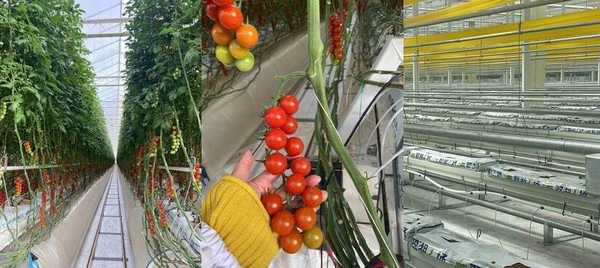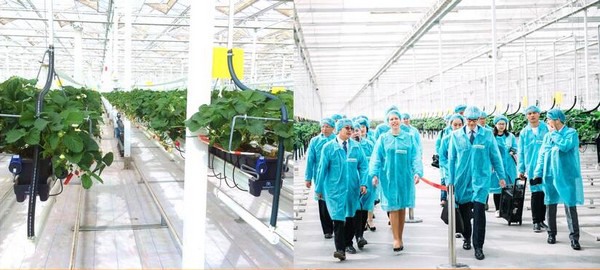China can provide important opportunities for Dutch greenhouse technology and know-how. Therefore, it is important that stakeholders in that field are aware of what is going on in the country. To facilitate that knowledge, the LAN team in Beijing and Shanghai has recently organized a roundtable, during which the Chinese shed light on the development in agricultural policies and practices on a national and regional level (Yangtze delta region and Shanghai).

Since the 1990s, an increasing number of high-tech greenhouses have been imported into China. Currently, there are about 1.000 hectares of high-tech greenhouses in the country. In recent years, however, the practicality and sustainability of these greenhouses have received critical comments by the Chinese horticulture industry. There is a discussion on two main issues: whether it is profitable to operate high-end glass greenhouses and whether more high-tech greenhouses are needed.
At the roundtable, the participants talked about the challenges that operating high-tech greenhouses in China brings.
From the growers’ and/or investors’ point of view
The advantages for growers to use high-tech greenhouses is that they can ensure a stable supply of high-end fresh products to their clients, compared to traditional cultivation. However, there are challenges for Chinese growers in terms of low investment and return ratio. Firstly, costs for growers are too high, particularly in constructing and operating the high-tech greenhouse. Most of the facilities, software, and hardware in the high-tech greenhouses are imported. Also, high energy consumption leads to high energy costs. A stable production throughout the year, especially when producing under extreme weather conditions, puts profits under pressure.
Secondly, growers mention difficulties because of insufficient after-sale services. The maintenance and repair of the facilities are heavily relying on suppliers. Suppliers are often foreign companies that do not have localized technical support or stock of accessories in the local market. Proper technical support from foreign suppliers sometimes takes too long, which can negatively impact their production.
In short, the investment is too high, especially the construction and energy costs.
From the retailers’/consumers’/investors’ point of view
The demand for fresh produce has increased a lot. Although the share of sales for fresh produce in online sales channels was increasing last years (from 2.8% in 2016 to 14.6 in 2020), offline channels that include wet markets, supermarkets, and community convenience shops are still the major sales channels of fresh produce that take 85.4% of the total market share in 2020.
A stable supply of products is essential to increase “customer stickiness.” Implementing digital facility agriculture in China is promising, but the following aspects need to be considered before the investment:
- Base production on sales: a good business model should have a good understanding of the triangular relationship between seed suppliers, growers, and retailers.
- Tailor measures to local conditions and customize supporting technologies.
- Postharvest preservation technology and fulfillment capabilities: especially the rapid and efficient pre-cooling of leafy vegetables and several types of berries.
In summary, the implementation of certain technologies is highly dependent on whether the business can be profitable.

From the researchers’ point of view
Protected cultivation in China still mainly relies on the standard plastic tunnel. The total protected cultivation area is 3.7 million hectares (data in 2018). The number of high-tech greenhouses installed has increased fast since 2010. Comparing with the area of standard plastic tunnels, the area of large-scale new types of high-tech greenhouses is small (about 1.000 hectares).
Investors or growers are expecting an equivalent yield in the high-tech greenhouses in China compared to production figures in the Netherlands. However, crop yield turns out to be lower in China. According to the experts, the optimal yield of crops is highly dependent on the climate management strategy that is used in these high-tech greenhouses. Compared to the Netherlands, climate conditions in China vary and there are more extreme weather occurrences. To adapt the climate control strategy, historical data on macro- and micro-climate in China is required. However, there is only limited accessibility for the industry to these historical data. This calls for contributions from the local authorities or research institutes. From the researcher’s point of view, the following three suggestions were made:
- Greenhouse climate zonation: as the climate in China varies a lot, the right type of greenhouse should be chosen for each specific location.
- Reducing energy costs: compared to Europe, there are more extreme climate conditions in China leads, which leads to higher energy consumption. There is a need to optimize the greenhouse structure and explore the use of renewable energy.
- More automation and better crop and climate management: labor cost is increasing in China. Resource use efficiency can be improved. Growers need a higher yield, and consumers are seeking for better-quality of the product.
In summary, the right type of greenhouse should be located at the right location to lower the need for energy consumption.

Protected agriculture requires an elevated level of professional knowledge and operational skills in auto and high-tech systems. The lack of technical, management, and operational personnel limits the development of protected agriculture and leads to a significant lack of promotion and application of results in the scientific research.
